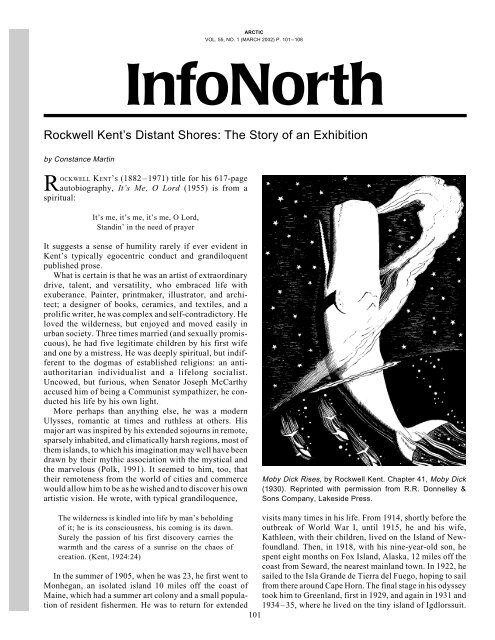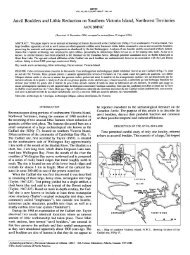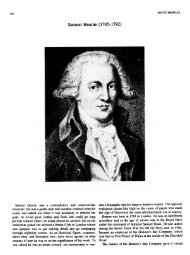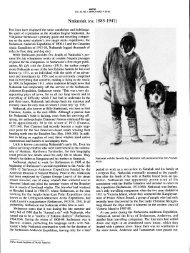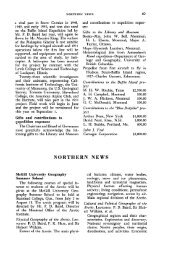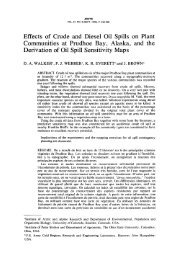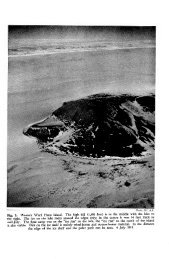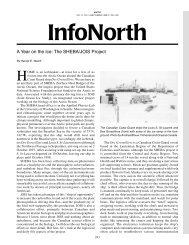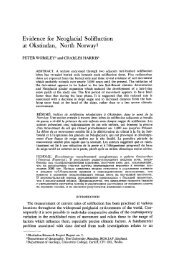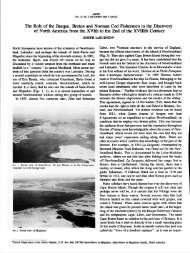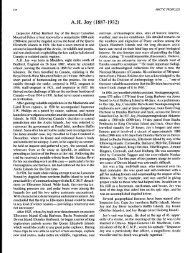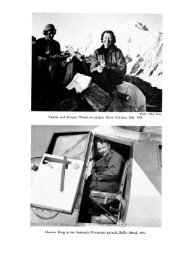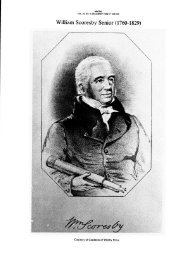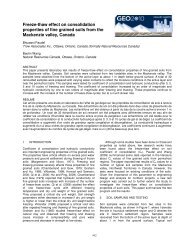InfoNorth - AINA Publications Server - University of Calgary
InfoNorth - AINA Publications Server - University of Calgary
InfoNorth - AINA Publications Server - University of Calgary
You also want an ePaper? Increase the reach of your titles
YUMPU automatically turns print PDFs into web optimized ePapers that Google loves.
ARCTIC<br />
VOL. 55, NO. 1 (MARCH 2002) P. 101–108<br />
<strong>InfoNorth</strong><br />
Rockwell Kent’s Distant Shores: The Story <strong>of</strong> an Exhibition<br />
by Constance Martin<br />
ROCKWELL KENT’S (1882–1971) title for his 617-page<br />
autobiography, It’s Me, O Lord (1955) is from a<br />
spiritual:<br />
It’s me, it’s me, it’s me, O Lord,<br />
Standin’ in the need <strong>of</strong> prayer<br />
It suggests a sense <strong>of</strong> humility rarely if ever evident in<br />
Kent’s typically egocentric conduct and grandiloquent<br />
published prose.<br />
What is certain is that he was an artist <strong>of</strong> extraordinary<br />
drive, talent, and versatility, who embraced life with<br />
exuberance. Painter, printmaker, illustrator, and architect;<br />
a designer <strong>of</strong> books, ceramics, and textiles, and a<br />
prolific writer, he was complex and self-contradictory. He<br />
loved the wilderness, but enjoyed and moved easily in<br />
urban society. Three times married (and sexually promiscuous),<br />
he had five legitimate children by his first wife<br />
and one by a mistress. He was deeply spiritual, but indifferent<br />
to the dogmas <strong>of</strong> established religions: an antiauthoritarian<br />
individualist and a lifelong socialist.<br />
Uncowed, but furious, when Senator Joseph McCarthy<br />
accused him <strong>of</strong> being a Communist sympathizer, he conducted<br />
his life by his own light.<br />
More perhaps than anything else, he was a modern<br />
Ulysses, romantic at times and ruthless at others. His<br />
major art was inspired by his extended sojourns in remote,<br />
sparsely inhabited, and climatically harsh regions, most <strong>of</strong><br />
them islands, to which his imagination may well have been<br />
drawn by their mythic association with the mystical and<br />
the marvelous (Polk, 1991). It seemed to him, too, that<br />
their remoteness from the world <strong>of</strong> cities and commerce<br />
would allow him to be as he wished and to discover his own<br />
artistic vision. He wrote, with typical grandiloquence,<br />
Moby Dick Rises, by Rockwell Kent. Chapter 41, Moby Dick<br />
(1930). Reprinted with permission from R.R. Donnelley &<br />
Sons Company, Lakeside Press.<br />
The wilderness is kindled into life by man’s beholding visits many times in his life. From 1914, shortly before the<br />
<strong>of</strong> it; he is its consciousness, his coming is its dawn. outbreak <strong>of</strong> World War I, until 1915, he and his wife,<br />
Surely the passion <strong>of</strong> his first discovery carries the Kathleen, with their children, lived on the Island <strong>of</strong> New-<br />
warmth and the caress <strong>of</strong> a sunrise on the chaos <strong>of</strong> foundland. Then, in 1918, with his nine-year-old son, he<br />
creation. (Kent, 1924:24)<br />
spent eight months on Fox Island, Alaska, 12 miles <strong>of</strong>f the<br />
coast from Seward, the nearest mainland town. In 1922, he<br />
In the summer <strong>of</strong> 1905, when he was 23, he first went to sailed to the Isla Grande de Tierra del Fuego, hoping to sail<br />
Monhegan, an isolated island 10 miles <strong>of</strong>f the coast <strong>of</strong> from there around Cape Horn. The final stage in his odyssey<br />
Maine, which had a summer art colony and a small popula- took him to Greenland, first in 1929, and again in 1931 and<br />
tion <strong>of</strong> resident fishermen. He was to return for extended 1934–35, where he lived on the tiny island <strong>of</strong> Igdlorssuit.<br />
101
102 • INFONORTH<br />
Ahab, by Rockwell Kent. Frontispiece, Moby Dick (1930).<br />
Reprinted with permission from R.R. Donnelley & Sons Company,<br />
Lakeside Press.<br />
Kent’s travels to these far-flung regions, which were in<br />
large part journeys <strong>of</strong> self-discovery, inspired much <strong>of</strong> his<br />
finest work and provided the chronological and geographical<br />
structure for the exhibition, Distant Shores: The Odyssey<br />
<strong>of</strong> Rockwell Kent. The show was organized by the<br />
Norman Rockwell Museum in Massachusetts, with me as<br />
a guest curator.<br />
My involvement in Distant Shores came about through<br />
a series <strong>of</strong> coincidental connections and surprises. A visit<br />
in the summer <strong>of</strong> 1995 to the museum brought to my mind<br />
the stunning power <strong>of</strong> Norman Rockwell’s semi-namesake<br />
and fellow illustrator, Rockwell Kent, best known for his<br />
illustrations <strong>of</strong> Herman Melville’s Moby Dick, the 19thcentury<br />
whaling saga set in the polar seas. My thoughts<br />
turned to Kent’s depiction <strong>of</strong> icebergs and high seas as an<br />
antidote to a hot summer day. This led to a discussion with<br />
the museum’s director about a possible exhibition <strong>of</strong> Kent’s<br />
art. Soon we were both filled with the kind <strong>of</strong> enthusiasm<br />
that happens only when the pieces <strong>of</strong> a puzzle fit perfectly.<br />
Melville’s house, where he created the American classic,<br />
was only a few miles away. Kent, like his contemporary<br />
Norman Rockwell, had lived in the area. He had married<br />
into a local family and painted many paintings <strong>of</strong> the<br />
surrounding country. Once I perceived the extent <strong>of</strong> Kent’s<br />
passion for the polar regions, I asked to be the curator.<br />
After five years <strong>of</strong> research and travel, I had tracked<br />
down over 100 works from private and public collections<br />
in many areas <strong>of</strong> the United States as far away as Alaska,<br />
as well as in eastern and western Canada and Russia.<br />
Distant Shores opened in June <strong>of</strong> 2000 and traveled from<br />
New England to Ocala, Florida, Chicago, and Anchorage.<br />
The most complicated negotiations involved the State<br />
Hermitage Museum in St. Petersburg. Senator Joseph<br />
McCarthy, in an attempt to label Kent a Communist, took<br />
away his passport and ordered all his illustrated books in<br />
overseas government libraries removed and burned (West,<br />
2000). In retaliation, Kent gave the Soviet Union a major<br />
selection <strong>of</strong> his paintings, watercolours, and drawings in<br />
the 1960s. Since then, many attempts to bring these works<br />
back to the United States for exhibition had failed. With<br />
the support and foresight <strong>of</strong> the Norman Rockwell Museum,<br />
I was able to visit the Hermitage collection and<br />
make a groundbreaking arrangement for the inclusion <strong>of</strong><br />
seven Greenland and Tierra del Fuego paintings. The<br />
accompanying book for Distant Shores was published by<br />
the <strong>University</strong> <strong>of</strong> California, Berkeley. In December 2001,<br />
the Los Angeles Times listed it as one <strong>of</strong> the best art books<br />
<strong>of</strong> the year.<br />
Aesthetically, Kent had much in common with such<br />
19th-century painters <strong>of</strong> the Arctic as Frederick E. Church<br />
and William Bradford, both <strong>of</strong> whom traveled to the Far<br />
North in search <strong>of</strong> those bleakly alien yet sublime landscapes<br />
described in the published narratives concerning<br />
the search for the Northwest Passage. For Kent, well<br />
versed in exploration literature, but not an armchair explorer,<br />
the lure <strong>of</strong> remote places was a search for spiritual<br />
fulfillment through his art, which found its inspiration in<br />
adventure, physical risk, and solitude.<br />
Kent began formal art studies at the age <strong>of</strong> ten, eventually<br />
studying at the New York School <strong>of</strong> Art. Encouraged<br />
by his parents to take up a pr<strong>of</strong>ession, he first enrolled in<br />
architecture at Columbia <strong>University</strong> and excelled in drafting,<br />
a skill requiring a precision that was to influence his<br />
later style. Before finishing a degree, he left Columbia to<br />
study art full-time. Important to his intellectual growth<br />
was the guidance <strong>of</strong> the artist Abbott Henderson Thayer<br />
(1849–1921), who was committed to the American transcendentalists,<br />
particularly Ralph Waldo Emerson (Traxel,<br />
1980). Thayer also stimulated Kent’s interest in the Far<br />
North by introducing him to the Icelandic sagas. Heroic<br />
feats during Kent’s youth, such as Roald Amundsen’s<br />
successful transit through the Northwest Passage in 1906<br />
and Robert Edwin Peary’s race to the North Pole in 1909,<br />
also aroused his interest. Later friendships with prominent<br />
Arctic explorers such as Knud Rasmussen, Peter Freuchen,<br />
and Vilhjalmur Stefansson were to further enrich his knowledge<br />
<strong>of</strong> the Arctic.<br />
But it was Robert Henri, the charismatic head <strong>of</strong> the<br />
New York School <strong>of</strong> Art, who started Kent on his odyssey.
Whaling Scene, by Rockwell Kent. Chapter 56, Moby Dick<br />
(1930). Reprinted with permission from R.R. Donnelley &<br />
Sons Company, Lakeside Press.<br />
In 1905, Henri encouraged his restless and talented student<br />
to visit the summer art colony on Monhegan Island, Maine,<br />
telling him <strong>of</strong> “such cliffs and pounding seas, as made me<br />
long to go there” (Kent, 1955:116). When Kent arrived on<br />
Monhegan, he was captivated, not so much by the art<br />
colony as by the island’s unspoiled wildness and the<br />
resident community <strong>of</strong> lobster fishermen.<br />
Responding to the rural beauty <strong>of</strong> the place, Kent decided<br />
to stay on through the winter and become part <strong>of</strong><br />
island life. He learned the skills <strong>of</strong> the lobster fishermen<br />
and experienced the darkness and biting cold <strong>of</strong> winter<br />
mornings. He relished the rugged terrain <strong>of</strong> the island and<br />
the isolation and solitude that, as he was discovering, his<br />
nature required. Here there seemed to be time for everything:<br />
Between and after days <strong>of</strong> work with maul and drill,<br />
with hammer and nails or at the oars, on days it blew too<br />
hard at sea, on Sundays, I was painting: painting with<br />
a fervor born...<strong>of</strong> my close contact with the sea and soil,<br />
and deepened by the reverence that the whole universe<br />
imposed. (Kent, 1955:137)<br />
INFONORTH • 103<br />
By the spring <strong>of</strong> 1907, Kent was able to exhibit 14 <strong>of</strong> his<br />
Monhegan paintings in New York. The New York Sun’s art<br />
critic wrote that Kent<br />
…knocks you <strong>of</strong>f your pins with these broad, realistic,<br />
powerful representations <strong>of</strong> weltering seas, men laboring<br />
in boats, rude rocky headland and snowbound<br />
landscapes… . The paint is laid on by an athlete <strong>of</strong> the<br />
brush….(Kent, 1955:147)<br />
Although the show was a critical success, it would be many<br />
years before Kent sold a painting.<br />
The life <strong>of</strong> Monhegan was an ideal Kent was to seek<br />
forever. Unfortunately, after he was married to his first<br />
wife, Kathleen, marital problems associated with a<br />
Monhegan girl from the past came to haunt him. In the<br />
interest <strong>of</strong> his family, he turned his eyes for the time away<br />
from Monhegan and to the North. Kent wrote:<br />
If minds can become magnetized, mine was: its compass<br />
pointed north…I set out for the golden North, for<br />
Newfoundland, to prospect for a homestead. (Kent,<br />
1955:204)<br />
In 1914, Kent settled with his wife and children in<br />
Brigus, Newfoundland, a once-thriving seaport village.<br />
Here he hoped to found an art school. All went well at first;<br />
the community welcomed him, and the family reveled in<br />
the apparent freedom <strong>of</strong> their newfound Garden <strong>of</strong> Eden.<br />
Matters began to turn when Kent, who had been to<br />
Germany in his youth and loved German music and songs,<br />
would traipse the hills singing them, with easel and paints<br />
under his arm. He made no effort to hide his admiration for<br />
German culture from the locals, whose anti-German sentiment<br />
was rising as World War I approached. As a result,<br />
many people, concluding that he might be a spy, prevailed<br />
on the government to exile him from the community. Some<br />
<strong>of</strong> the inhabitants remained friends throughout the crisis,<br />
including two members <strong>of</strong> the Bartlett family active in<br />
Arctic expeditions (Kent, 1955). They were sufficiently<br />
appalled at what was happening to appeal to the government<br />
to reverse the decision, but it was too late, and the<br />
Kents returned to New York with three sick children and an<br />
infant, on a ticket paid for by Kent’s mother (Kelly, 1987).<br />
Several <strong>of</strong> Kent’s Newfoundland paintings reflect the<br />
frustration and humiliation he and his wife Kathleen lived<br />
through as a result <strong>of</strong> the experience. The House <strong>of</strong> Dread<br />
(Martin, 2000:64–65), a powerful composition reminiscent<br />
<strong>of</strong> the maritime paintings <strong>of</strong> Lawren Harris (1885–<br />
1970) (Larisey, 1993), shows a bleak house on the right<br />
with a woman leaning or falling from a second-story<br />
window and a man below with head bowed against the<br />
wall. Kent (1955:260) wrote: “It is ourselves in Newfoundland,<br />
our hidden but prevailing misery revealed.”<br />
The suffering inspired some <strong>of</strong> Kent’s most moving art<br />
and a surprising response many years later. In the 1960s,<br />
Joey Smallwood, then premier <strong>of</strong> Newfoundland,
104 • INFONORTH<br />
certainly one <strong>of</strong> Canada’s most vibrant personalities and a<br />
great admirer <strong>of</strong> Rockwell Kent, came across Kent’s government<br />
file. The premier was shocked and horrified.<br />
Deciding to rectify the stupidity <strong>of</strong> the community’s provincialism,<br />
Smallwood invited Kent back for a public<br />
apology and a week <strong>of</strong> festivities. So 53 years later, Kent<br />
returned with his third wife, Sally. At a luncheon for over<br />
200 guests, the premier and Kent regaled their audience<br />
with the story <strong>of</strong> “Newfoundland’s Famous Spy.” In appreciation,<br />
Kent wrote a charming book (After Long Years,<br />
1968) enhanced by drawings from his time in Brigus and<br />
dedicated to Joseph Smallwood.<br />
Monhegan and Newfoundland confirmed Kent’s love<br />
<strong>of</strong> the North:<br />
I crave snow-topped mountains, dreary wastes, and the<br />
cruel Northern sea with its hard horizons at the edge <strong>of</strong><br />
the world where infinite space begins. Here skies are<br />
clearer and deeper and, for the greater wonders they<br />
reveal, a thousand times more eloquent <strong>of</strong> the eternal<br />
mystery than those <strong>of</strong> s<strong>of</strong>ter lands. (Kent, 1996a:xxviii)<br />
In 1918, Kent again turned his back on the commercial<br />
art world. With a free passage aboard the S.S. Admiral<br />
Schley, he sailed to Alaska, accompanied by his nine-yearold<br />
son, Rockwell Jr., arriving in Seward in August. Kent,<br />
always resourceful, made friends with an aging trapper<br />
named Olson, who persuaded the artist and his young son<br />
to come to his home on tiny Fox Island, 12 miles below<br />
Seward in Resurrection Bay. Here life was reduced to the<br />
elemental, and father and son began a nine-month adventure<br />
that surpassed the most vivid <strong>of</strong> childhood dreams.<br />
“It’s a fine life,” wrote Kent in a letter, “and more and more<br />
I realize that for me at least such isolation…is the only<br />
right life for me”(Kent, 1996a:106).<br />
Isolation, however, is a two-edged sword. At one time<br />
he writes, “I have terrible moments” (Kent, 1996a:xii),<br />
and at another, he explains his ambivalence:<br />
There is discomfort, even misery in being cold. The<br />
gloom <strong>of</strong> the long and lonely winter nights is appalling<br />
and yet do you know I love this misery and court it.<br />
(Kent, 1996a:xxviii)<br />
On the more positive side, he found plenty <strong>of</strong> time for<br />
painting, study, and reflection as he immersed himself in<br />
the literature <strong>of</strong> such thinkers as William Blake and Friedrich<br />
Nietzsche, seeing himself as a modern superman. Surrounded<br />
by the natural forms <strong>of</strong> trees, the sea, the sun, and<br />
the northern light, Kent composed pictures that, like those<br />
in Newfoundland, projected an iconography both personal<br />
and Christian. Many <strong>of</strong> the paintings <strong>of</strong> this period again<br />
recall Kent’s friend, theosophist Lawren Harris. Though it<br />
has yet to be established when Kent and Harris first met, the<br />
connection is confirmed by the fact that Harris owned<br />
prints <strong>of</strong> Kent’s Alaskan paintings (Larisey, 1993:30). The<br />
Alaskan sojourn was a turning point in Kent’s career. His<br />
reputation was established by the success <strong>of</strong> the subsequent<br />
gallery showing <strong>of</strong> his paintings and by the publication in<br />
1920 <strong>of</strong> his book Wilderness: A Journal <strong>of</strong> Quiet Adventure<br />
in Alaska, based on his diaries and letters and illustrated<br />
with his drawings.<br />
Back in New York in 1919, Kent was unable to settle<br />
down. By 1922, hoping to escape once again from personal<br />
problems, his familiarity with Baron George Anson’s<br />
voyage around the Horn in the 1740s (Martin, 2000:30)<br />
impulsively led him to follow in Anson’s footsteps and<br />
book passage to Tierra del Fuego. Rationalizing his decision,<br />
he wrote:<br />
Forever shall man seek the solitudes, and the most utter<br />
desolation <strong>of</strong> the wilderness to achieve through hardship<br />
the rebirth <strong>of</strong> his pride. [The place to which he was<br />
going seemed to <strong>of</strong>fer the]…spirit-stirring glamour <strong>of</strong><br />
the terrible. (Kent, 1924:2)<br />
Once again leaving his wife and children in May 1922,<br />
Kent sailed to the Straits <strong>of</strong> Magellan aboard the S.S.<br />
Curaca, landing at Punta Arenas six weeks later. This<br />
adventure Kent recorded in his illustrated Voyaging: Southward<br />
from the Strait <strong>of</strong> Magellan (1924). A wood engraving<br />
also entitled Voyaging, which he did for a deluxe<br />
edition <strong>of</strong> the book, is a self-portrait, commemorating<br />
Kent’s extraordinary hike over the Brecknock Pass below<br />
Admiralty Sound to Ushuaia, the southernmost town in the<br />
world (Martin, 2000:30). The engraving portrays an idealized,<br />
muscular Kent, a dignified figure <strong>of</strong> Olympian size<br />
gazing toward the viewer from the summit, with a forested<br />
valley and snowcapped mountains in the background.<br />
Kent and his companions did try to sail around the Horn in<br />
a converted lifeboat, but fog, cold, and a perpetual gale<br />
forced them to turn back, lucky to be alive. When Kent<br />
returned home, his long-suffering wife, Kathleen, hoped<br />
that he had completed the last <strong>of</strong> his therapeutic voyages.<br />
She was wrong: other adventures were to follow. The<br />
couple divorced in 1925, and the following year Kent<br />
married Frances Lee, a beautiful and intelligent woman in<br />
her twenties, who devoted her time to editing his writings<br />
and managing his complicated career.<br />
Kent’s expenses were now considerable. To support his<br />
divorced wife and children, he needed to accept commercial<br />
assignments, which, for an artist <strong>of</strong> his reputation,<br />
were not hard to come by. He was approached in 1926 by<br />
R.R. Donnelley & Sons, the large Chicago press, to illustrate<br />
an American classic for their elegantly designed<br />
Lakeside Series. Kent chose Herman Melville’s Moby<br />
Dick, first published in 1851, which the reading public for<br />
a good many years had largely ignored. It was to be one <strong>of</strong><br />
the most successful projects <strong>of</strong> his career. The book and<br />
Kent were well matched, Ahab’s obsessive quest for the<br />
Great White Whale harmonizing with Kent’s equally obsessive<br />
search across thousands <strong>of</strong> miles <strong>of</strong> ocean for selffulfillment.<br />
Four years <strong>of</strong> research prepared Kent well for<br />
the task. He read much <strong>of</strong> the literature on whaling,
including in all probability William Scoresby’s Account <strong>of</strong><br />
the Arctic Regions and <strong>of</strong> the Whale Fishery (1820), cited<br />
by Melville in Moby Dick and <strong>of</strong>ten mentioned to this day<br />
as “a classic <strong>of</strong> whaling literature” (Martin, 1988:40).<br />
Donnelley’s enthusiasm for the first group <strong>of</strong> drawings<br />
that Kent submitted was immense:<br />
These drawings have excited the greatest interest and<br />
approval <strong>of</strong> every one who has seen them here. They<br />
exceed our highest expectation <strong>of</strong> how you would do<br />
this work. As works <strong>of</strong> art, reflecting the spirit <strong>of</strong><br />
Melville’s book, they could not be finer…The work has<br />
our utmost devotion and its successful accomplishment<br />
is our most important objective. (Badaracco, 1992:37)<br />
Perhaps thinking (like Melville) that meditation and<br />
water are wedded forever, Kent succumbed to temptation<br />
before he had completed more than half the drawings. In<br />
1929, he accepted an invitation to help crew a small sailing<br />
boat to Greenland, a journey that he and his two young<br />
companions barely survived when they were shipwrecked<br />
in Karajak Fiord on the island’s west coast. Just as Kent<br />
had found his way over the Brecknock Pass in Argentina<br />
(Martin, 2000), summoning Herculean deliberation, he<br />
managed their rescue by climbing alone for three days over<br />
rivers, mountains, and boggy plains until he regained the<br />
sea and was rescued by a lone Greenlander in a kayak. The<br />
Greenlander guided him to a settlement where he obtained<br />
help for his shipwrecked crew. It was just the kind <strong>of</strong><br />
introduction to a new place that Kent thrived on. He fell in<br />
love with Greenland and spent the summer painting and<br />
making many friends. Like Gauguin in the South Seas,<br />
Kent in the frozen North found an indigenous people,<br />
warm and sensuous, whose community he wished to be a<br />
part <strong>of</strong>. The Greenlanders’ way <strong>of</strong> life, isolated from the<br />
conventions <strong>of</strong> Western society, self-contained and selfsufficient,<br />
totally charmed him. He recorded the time in his<br />
book N by E (1996b). During the same summer, he also met<br />
two distinguished Arctic ethnographers, Peter Freuchen<br />
and Knud Rasmussen, who would encourage him to make<br />
his two subsequent trips to Greenland. At the end <strong>of</strong> the<br />
summer, he accepted their invitation to return with them to<br />
Denmark where, joined by his wife Frances, he completed<br />
the Moby Dick illustrations.<br />
Published in 1930, Donnelly’s deluxe edition sold out<br />
rapidly, and a less expensive edition contracted to Random<br />
House and containing 270 <strong>of</strong> the original 280 illustrations<br />
appeared the same year. The extent <strong>of</strong> its popularity can be<br />
gauged by its choice as a Book-<strong>of</strong>-the-Month Club selection<br />
and by Robert Frost’s tribute to Kent’s artistry nearly<br />
20 years later. In Frost’s dramatic poem A Masque <strong>of</strong><br />
Mercy, the ‘Bookseller’ says to a potential customer who<br />
has asked about a whaling story, “Oh, you mean Moby<br />
Dick/By Rockwell Kent that everybody’s reading” (Frost,<br />
1947:4). Melville’s death in 1891 had passed almost unnoticed.<br />
It might be said, without too much exaggeration, that<br />
Rockwell Kent brought him back to life.<br />
INFONORTH • 105<br />
The Donnelley edition <strong>of</strong> Moby Dick has been lauded<br />
for its integration <strong>of</strong> text and story and for its energy and<br />
suggestive power as a masterpiece <strong>of</strong> 20th-century book<br />
illustration.<br />
Kent’s identification with Melville’s story jumps from<br />
the page, as in Moby Dick Rises, where the white whale,<br />
seen above and below the surface piercing the heavenly,<br />
starlit sky, seems indeed a force to strike terror in the heart<br />
<strong>of</strong> Ahab himself. One finds in many <strong>of</strong> the Moby Dick<br />
illustrations connections with the imagery from Kent’s<br />
earlier adventures, such as the sailing adventure in N by E<br />
and his time on Monhegan Island.<br />
On the advice <strong>of</strong> Peter Freuchen, Kent returned to the<br />
west coast <strong>of</strong> Greenland in 1931, settling on the island <strong>of</strong><br />
Igdlorssuit, about 360 kilometres north <strong>of</strong> the Arctic Circle.<br />
Knud Rasmussen arranged for Kent to have at his<br />
disposal a team <strong>of</strong> eight dogs. Salamina, the lovely Greenland<br />
girl he was to paint and write two books about,<br />
Salamina (1935) and Greenland Journal (1962), came to<br />
live with him. Later in the year, Frances joined him. In<br />
1934, on his third and last visit, Kent was accompanied by<br />
his 14-year-old son Gordon, who today lives in upstate<br />
New York and takes an active interest in promoting his late<br />
father’s art.<br />
In the early 1930s, Kent met the eminent Arctic explorer<br />
and writer Vilhjalmur Stefansson (1879–1962), and the<br />
two became close friends. In the 1940s, Stefansson asked<br />
Kent to contribute text and illustrations to his Encyclopedia<br />
Arctica, an ambitious 17-volume work funded by the<br />
U.S. Government. Describing the project, Stefansson<br />
(1948:45) wrote, “Rockwell Kent, our contributor on the<br />
scenic qualities <strong>of</strong> arctic lands, is foremost <strong>of</strong> all artists<br />
who have ever spent whole years at a time in the Arctic.”<br />
As to whether the Encyclopedia should include colour<br />
plates, he declared:<br />
There is a commercial argument for it, since the pictures<br />
<strong>of</strong> artists like Rockwell Kent, who is doing the papers<br />
on Greenland and Alaska scenery, will add considerably<br />
to sales volume. (Stefansson, 1948:46)<br />
Shockingly, though the writing <strong>of</strong> this monumental project<br />
was near completion, Senator McCarthy, under the guise<br />
<strong>of</strong> saving the world from Communism, suppressed its<br />
publication. It now exists in typescript, in a few libraries,<br />
including that <strong>of</strong> the <strong>University</strong> <strong>of</strong> <strong>Calgary</strong>, and on micr<strong>of</strong>ilm.<br />
Of all the stages in Kent’s odyssey, Greenland was his<br />
favorite and gave rise to the largest body <strong>of</strong> work. Greenland<br />
is the subject <strong>of</strong> a major portion <strong>of</strong> the more than 80<br />
paintings that Kent gave to Russia. These “…paintings <strong>of</strong><br />
Greenland have become documents <strong>of</strong> a culture now lost to<br />
advanced technology” (Ferris and Pearce, 1998:88). For<br />
the rest <strong>of</strong> his life until his death, Kent continued to paint<br />
and repaint many <strong>of</strong> the pictures <strong>of</strong> this beautiful land. It<br />
was for Kent an island <strong>of</strong> magic in which, by disclosing its<br />
secrets, he found happiness:
106 • INFONORTH<br />
How rich in everything was Greenland! Whether I<br />
sought the wilderness to find in mountain forms the<br />
substantive <strong>of</strong> abstract beauty or to renew through<br />
solitude the consciousness <strong>of</strong> being; or whether, terrified<br />
by both, I turned gregarious and needed love or<br />
friendship or to rub shoulders in a Greenland dance—<br />
all everything was there. And no more complete with<br />
majesty were the mountains, nor limitless the ocean,<br />
than human kind seemed what it ought to be. (Kent,<br />
1996b:226)<br />
All day intermittently the snow has been gently falling—<br />
floating downward, it seemed to lay itself most gently<br />
over all the world…. Whiter than snow appear the<br />
moonlit mountains; and the shadows are luminous with<br />
the reflected light <strong>of</strong> the white universe...young<br />
people…begin to sing…. And their voices heard in<br />
harmony are as beautiful as the night itself, and like the<br />
moonlight, clear and sweet. (Johnson, 1976:171)<br />
Kent’s artistic imagination was both visual and literary.<br />
It was the literary, however, that first drew Kent to the Far<br />
North and the polar seas. His early reading <strong>of</strong> Icelandic<br />
sagas and his study <strong>of</strong> the exploration narratives <strong>of</strong> the<br />
various searches for the Northwest Passage provided Kent<br />
with the stimulus to experience for himself “…the Far<br />
North at its spectacular worst” (Kent, 1955:452). The<br />
power <strong>of</strong> his illustrations for Moby Dick comes from both<br />
his incisive literary perception <strong>of</strong> Melville’s great novel<br />
and his own firsthand encounters with the polar seas.<br />
Distant Shores was an exhibition designed to show the<br />
art that Kent created in paintings, engravings, and books<br />
out <strong>of</strong> his response to the Far North, the polar seas, and the<br />
wilderness that he himself confronted. These works reflect<br />
his deep belief that his art and his life were one and<br />
the same.<br />
REFERENCES<br />
BADARACCO, C. 1992. American culture and the marketplace:<br />
R.R. Donnelley’s four American books campaign, 1926–1930.<br />
Washington, D.C.: Library <strong>of</strong> Congress.<br />
FERRIS, S.R., and PEARCE, E. 1998. Rockwell Kent’s forgotten<br />
landscapes. Camden, Maine: Down East Books.<br />
FROST, R. 1947. A masque <strong>of</strong> mercy. New York: Henry Holt.<br />
JOHNSON, F., ed. 1976. The illustrations <strong>of</strong> Rockwell Kent. New<br />
York: Dover <strong>Publications</strong>.<br />
KENT, R. 1924. Voyaging southward from the Strait <strong>of</strong> Magellan.<br />
New York: G.P. Putnam & Sons.<br />
———. 1935. Salamina. New York: Harcourt, Brace and Company.<br />
———. 1955. It’s Me, O Lord. New York: Dodd Mead & Co.<br />
———. 1962. Rockwell Kent’s Greenland journal. New York:<br />
Ivan Obolensky.<br />
———. 1968. After long years. Ausable Forks, New York: Asgaard<br />
Press.<br />
———. 1996a. Wilderness: A journal <strong>of</strong> quiet adventure in Alaska.<br />
Foreword by Doug Capra. Hanover, New Hampshire: <strong>University</strong><br />
Press <strong>of</strong> New England.<br />
———. 1996b. N by E. Hanover, New Hampshire: <strong>University</strong><br />
Press <strong>of</strong> New England.<br />
KELLY, G. 1987. Rockwell Kent: The Newfoundland work. Halifax,<br />
Nova Scotia: Dalhousie Art Gallery, Dalhousie <strong>University</strong>.<br />
LARISEY S.J., P. 1993. Light for a cold land: Lawren Harris’s<br />
work and life—An interpretation. Toronto: Dundurn Press.<br />
MARTIN, C. 1988. William Scoresby, Jr. (1789–1857) and the<br />
open polar sea—Myth and reality. Arctic 41(1):39–47.<br />
———. 2000. Distant shores: The odyssey <strong>of</strong> Rockwell Kent.<br />
Berkeley, California: Chameleon Books, <strong>University</strong> <strong>of</strong> California<br />
Press.<br />
MELVILLE, H. 1930. Moby Dick or the whale. Chicago: R.R.<br />
Donnelley & Sons Company, Lakeside Press.<br />
POLK, D.B. 1991. The island <strong>of</strong> California: A history <strong>of</strong> the myth.<br />
Spokane, Washington: Arthur H. Clark Co.<br />
STEFANSSON, V. 1948. Encyclopedia Arctica. Arctic 1(1):<br />
44–46.<br />
TRAXEL, D. 1980. An American saga: The life and times <strong>of</strong><br />
Rockwell Kent. New York: Harper & Row.<br />
WEST, R.V. 2000. Rockwell Kent: After the odyssey. In: Martin,<br />
C. Distant shores: The odyssey <strong>of</strong> Rockwell Kent. Berkeley,<br />
California: Chameleon Books, <strong>University</strong> <strong>of</strong> California Press.<br />
113–121.<br />
Constance Martin is a research associate and art curator at the<br />
Arctic Institute <strong>of</strong> North America.


